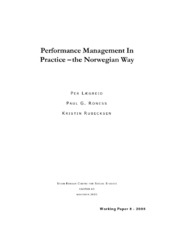| dc.contributor.author | Lægreid, Per | eng |
| dc.contributor.author | Roness, Paul G. | eng |
| dc.contributor.author | Rubecksen, Kristin | eng |
| dc.date.accessioned | 2006-06-20T14:08:04Z | |
| dc.date.accessioned | 2020-12-10T06:32:26Z | |
| dc.date.available | 2006-06-20T14:08:04Z | |
| dc.date.available | 2020-12-10T06:32:26Z | |
| dc.date.issued | 2005-11 | eng |
| dc.identifier.issn | 1503-0946 | |
| dc.identifier.uri | https://hdl.handle.net/1956/1335 | |
| dc.description.abstract | This paper examines how the Norwegian system of performance management, Management-By-Objectives-And-Results (MBOR), works in practice in civil service organizations. To do this it focuses on the formulation of goals and performance indicators, performance reporting and performance steering. The empirical basis is a broad survey of Norwegian state agencies carried out in 2004. Using variables derived from a structural-instrumental, a cultural-institutional and an environmental approach, we analyze the variations among agencies in their use of MBOR. While the general ideas of MBOR have been widely adopted in the Norwegian central government, the practical application of MBOR differs considerably from the ideal performance-management model and has been transformed and translated by the various agencies. This variation can primarily be attributed to cultural and environmental factors. The MBOR model seems to work best for agencies that are young and large, that are subject to some form of market competition, and that report a very high level of mutual trust between the agency and the parent ministry. | en_US |
| dc.description.abstract | I dette notatet undersøkes det hvordan mål- og resultatstyring fungerer i praksis i norsk sentralforvaltning. Det fokuseres på målformulering, resultatindikatorer, resultatrapportering og resultatoppfølging. Det empiriske grunnlaget er en større spørreundersøkelse til alle statlige forvaltningsorganer som ble gjennomført i 2004. Med utgangspunkt i et strukturelt-instrumentelt perspektiv, et kulturelt-institusjonelt perspektiv og et omgivelsesperspektiv undersøkes variasjoner mellom forvaltningsorganene i bruk av mål- og resultatstyring. Studien avdekker at de generelle ideene i mål- og resultatstyringen i stor grad har blitt adoptert i norsk sentraladministrasjon, men også at den praktiske tilpasningen av mål- og resultatstyring varierer betydelig fra den idealtypiske modellen og har blitt omformet og tilpasset av de ulike forvaltningsorganene. Denne variasjonen kan særlig knyttes til kulturelle faktorer og omgivelsesforhold. Mål- og resultatstyring synes å fungere best for forvaltningsorganer som er unge og store, som fungerer under markedslignende forhold, og som rapporterer om høg grad av gjensidig tillit mellom forvaltningsorganet og overordnet departement. | no |
| dc.format.extent | 494521 bytes | eng |
| dc.format.mimetype | application/pdf | eng |
| dc.language.iso | eng | eng |
| dc.publisher | Stein Rokkan Centre for Social Studies | eng |
| dc.relation.ispartofseries | 8-2005 | |
| dc.relation.ispartofseries | Working Paper | en |
| dc.title | Performance Management In Practice – the Norwegian Way | eng |
| dc.type | Working paper | eng |
| dc.subject.nsi | VDP::Samfunnsvitenskap: 200 | nob |
